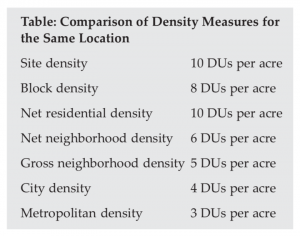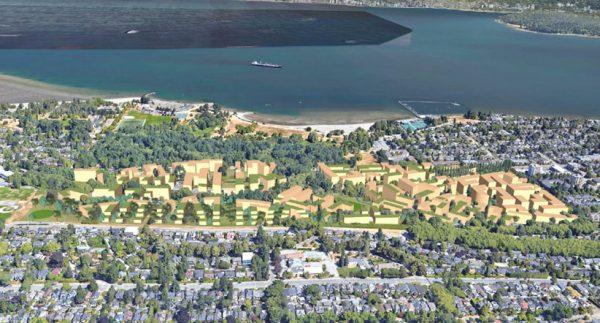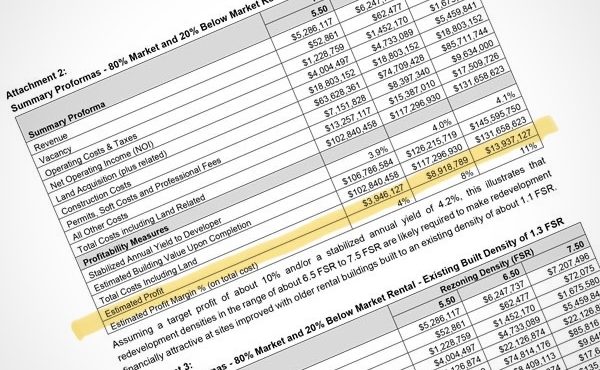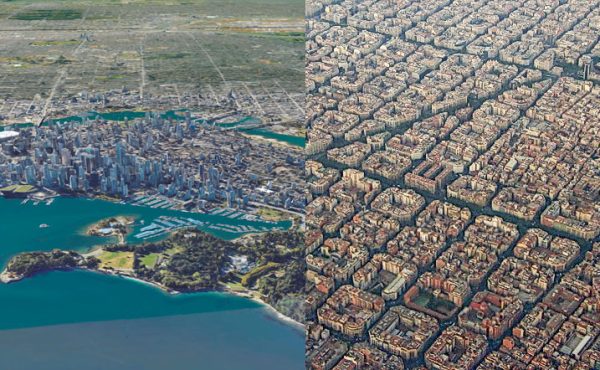What is residential density and why is it so confusing?
Residential density is critical to urban planning. It refers to the number of people living in a specific area and is significant because it helps us understand how densely populated an area is. It’s also very controversial. In certain folks, increasing density evokes fear about large buildings, unruly people and parking problems. In other circles, it’s associated with walkable neighbourhoods, more housing options and better infrastructure. This points to the fact that there’s an unfortunate lack of clarity around the issue of residential density: what it means, and how it’s measured.
Let’s see if we can clear things up a little.
As mentioned, at its most basic, density refers to the number of people living in a specific area. It’s usually measured in terms of people per square kilometer, people per square mile, dwelling units per hectare or dwelling units per acre. Although the latter is arguably the most commonly used in zoning and development reviews, all are useful in their own way, giving people different information about the area being considered. It’s worth noting, though, that there is no ‘standard’ definition of density. Each discipline develops its own method of discussing the issue: a key aspect of why it’s so baffling.
Here are the other common points of confusion about density:
There is no standard for “high”, “medium”, and “low” densities
Talking about “low”, “medium”, and “high” densities is common in planning circles, but there is absolutely no agreement about what that means in real terms. A “high-density” neighbourhood in Toronto may be considered “low density” in Hong Kong.
Associating density with specific building types
It’s often assumed, for example, that detached houses are lower density than attached housing or that high residential density is synonymous with high-rise buildings. This is not always the case. A tower with large units located in a park-like setting can have a lower density than a set of detached houses on small lots.
Relating density to social and economic characteristics of residents
Too frequently, ‘high densities’ are wrongly connected to high-crime neighbourhoods with renters and low-income households. This misperception leads to underestimating the residential densities of wealthier areas with larger numbers of owners. Simply put: density and socio-economic conditions are separate issues but relate depending on the context and the architectural form a certain density takes.
Density versus crowding
Concerns connecting too many people living together—crowding—and increased densities are common. These two terms are unrelated. Crowding refers to people per room, per square foot, or per bedroom. Many people live in very high-density developments spacious apartments with no crowding. Similarly, a detached farmhouse can be crowded by having a lot of people per room.
Household size affects population density
An example: a site with 15 dwelling units per acre can have a density of 20 people per acre if the area is full of empty nesters and elderly people, or a density of 40 people per acre if families with children or extended families live there. Similarly, a tower targeted at couples with no kids can have a lower number of people per acre than a mid-rise development targeted at families with children. The devil is in the details. This difference can have a huge impact in terms of how many people are available to support community services, transit, and infrastructure. Given that regulating household size is a challenge for governments, policies tend to focus on dwelling unit densities as a surrogate.
Base land area matters
What’s included and excluded in terms of land area is critical to the density number. Is it for the block? The parcel? The entire neighbourhood? Density numbers can vary widely within the boundaries of the study area. The table below shows density numbers for a hypothetical site with the same residential site density in dwelling units per acre. How different measures can be, based on different density definitions, is explicitly clear.

Net versus Gross Density
As mentioned, residential density is often expressed in dwelling or housing units per acre. This can be measured as “net” or “gross”, a topic worth looking at more closely in another S101S. Very quickly, however, “net density” refers to the number of units per acre within a specific land area devoted to residential purposes. This often includes driveways, private yards, and additional residential accessory structures while excluding public rights of way, parks, open spaces, and other non-residential land uses.
“Gross density”, on the other hand, means the density of a given area (typically) including all types of land uses, including infrastructure such as streets, sidewalks, and public spaces. This gives us a more comprehensive understanding of the overall land use in an area but often results in lower density since including non-residential increases land area and the resulting units-to-land ratio. Also worth noting is the fact that mixed-use urban neighbourhoods tend to have lower densities than ones that are primarily residential.
Two more important things about net and gross densities. First, the above are definitions are generally true, what is included “net” and “gross” density definitions do differ slightly from place to place. So, what is considered within each definition needs to be specified by locale. Second, too many public and internal documents citing densities don’t even specify whether the numbers are “net” and “gross,” let alone the specifics of each definition. This leads to large misinterpretations of density information by the public, as well as government officials.
Whew….that was a lot. But that covers the majority of issues that make residential density a headache, despite its usefulness. This won’t be the last we see of residential density in S101S—we haven’t even mentioned Floor Space Ratio or zoning regulations…Yikes!—but it’s a decent start.
So, a quick recap: what’s residential density and why does it matter?
Well, at its most basic, residential density is a calculation of people living in a specific area: a number that can be helpful for understanding a location and planning changes, accordingly. At a very, very general level, higher residential densities can mean that there are more people living in a smaller area, making the area more densely populated. What this means in terms “look and feel” however is a large question mark with many possibilities. So, higher density can—but might not—lead to more efficient use of land, more convenient access to public transportation, and a wider variety of shopping and cultural opportunities. It can also mean—but may not—increased traffic, noise, as well as a lack of open space and privacy. Ultimately, it depends on a host of other decisions, some of which we’ll encounter in other S101S pieces.
In summary:
- Residential density refers to the number of people living in a specific area and is used frequently for urban planning and development decision-making.
- Density is controversial since what it means and how it’s measured is unclear.
- Density numbers are relative. That is, there is no standard definition for “high”, “medium”, and “low” densities. Context matters.
- Density may or may not relate to specific building types. It depends.
- Density may or may not relate to social and economic characteristics of residents. It depends.
- Density and crowding are very different and unrelated issues.
- Household size affects population density numbers. Demographics matter.
- Base land area directly affects density measures.
- Net and gross density differ in focus. Broadly, net density focuses on the residential component of population density, while gross density takes into account all land uses. But specifics matter.
- Frequently, public documents that include density measures do not explicitly cite whether net or gross densities are being communicated. This often leads to misinterpretations of density information.
- In general, gross densities are lower than net densities since they include larger areas including public rights of way.
- Broadly, mixed-use urban neighbourhoods tend to have lower densities than ones that are primarily residential. But it depends.
***
Some Useful Resources:
- Measuring Density: Working Definitions for Residential Density and Building Intensity by Ann Forsyth
- Demystifying Density: A comparison of different forms of density in five case studies in the Greater Vancouver Region by Patrick Condon, Jone Belausteguigoitia, Sara Fryer, and Kristi Tatebe
- Julie Campoli: Visualizing Density
**
Related pieces in the S101S:
- S101 Series: Introduction and Call
- S101S: Understanding Residential Density: Net vs Gross Density
- S101S—Understanding Residential Density: FSR, Building Setbacks and Height Regulations
*
Erick Villagomez is the Editor-in-Chief at Spacing Vancouver.






One comment
Good stuff!!!